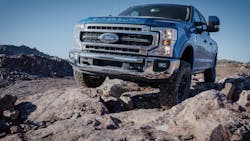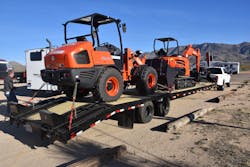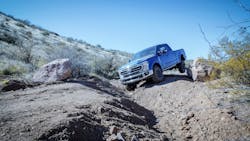Behind the wheel of a new 2020 Ford Super Duty F-350 XLT Tremor, I waited for instructions.
“Ready when you are,” said my passenger, Robbie Calkins, Super Duty vehicle integration engineer. He pointed straight ahead. “Let’s go.”
I laughed, hoping he was joking. The jagged pile of boulders in front of us could’ve doubled as the surface of another planet, the desolate sort of place where the astronauts know they’re in big trouble as soon as they open the hatch.
How did I get here? More importantly, like the astronauts, how am I going to get out of this?
Basically, this is what happens when a journalist strays from his lane. All I needed was a cover photo. As we do every January, Trailer/Body BUILDERS features a preview of The Work Truck Show. The show is the biggest event of the year for that part of our readership that builds and sells truck equipment (it’s also one of the biggest commercial vehicle exhibitions, period), and we try to leave a copy of the magazine on about any elevated horizontal surface in the Indianapolis Convention Center.
So I’m thinking (uh-oh) that, for 11 months of the year any truck on the cover of the magazine is just there as a platform for a new trailer or a distinctive body design. Of course our readers love trucks—where else would the body go?—but there are plenty of magazines devoted to pickups with hero shots galore. It’s just never been a TBB thing. But still, this time, let’s actually feature a truck for The Work Truck Show preview cover. Genius!
I recalled that somewhere in my email inbox was an invitation from Ford asking if I’d be interested in a test drive of the new 2020 Super Duty. And, as Fate would have it, because of a 3-day holiday weekend, our print deadline for this issue would be delayed. I could get to Phoenix and back just in time.
I called Elizabeth Kraft, the Ford CV communications manager, to make sure a real, bodied-up work truck would be available at the Super Duty launch. She assured me that I could get behind the wheel of a Super Duty with a dump body or one with a utility body; and, if so inclined, I could also take a Super Duty with the Tremor Off-Road Package for a spin.
Well, if I must.
So a couple of dozen truck and off-road journalists gathered at sunrise in a suburban Phoenix parking lot, paired up, picked a truck, switched on the pre-programmed navigational guide and headed west. Jonathan Hanson, who’s written for a number of travel and adventure magazines (find more at his website, exploringoverland.com) took his turn at the wheel of our 2020 F-350 SRW Platinum 4X4 Crew Cab for the outbound leg of our 100-mile trip into the desert.
Coincidentally, Hanson is the long-time owner of a 2004 F-350 SuperCab 4X4 with a 6.0-liter turbodiesel—a truck that, with some heavy-duty upgrades, he still uses to pull a trailer full of wilderness gear back and forth across the country. In short, he was well qualified to rate the 2020 Super Duty and share his insight.
While the new model provided all the conveniences of a modern, fully loaded truck and then some (adaptive steering; lane-keeping alert; Ford's Blind Spot Information System (BLIS) with cross-traffic alert; 10-speaker Bang and Olufsen sound system; trailer tow camera system with Pro Trailer Backup Assist; and voice-activated navigation, to name a few) our first leg was notable for the quiet cab interior and the sedan-smooth ride, especially in a 4X4 over that last 20-mile stretch that wasn’t paved.
Of course, much of that quiet was the noise we didn’t hear from the 475-hp 6.7-liter Power Stroke V8, matched to a 10-speed automatic. And this 2020 Super Duty’s 1,050 ft.-lbs. of torque is nearly twice that of Hanson’s 2004. Press the accelerator with some enthusiasm and you get G-forces, not diesel rattle.
User error
But a funny thing happened on the way to the Big Horn Pit: All that comfort, conversation and reliance on satellite routing (rather than on the step-by-step directions on the Ford-provided card I left sitting in the console) meant, unbeknown to us, we missed a turn; and, instead of the off-road course, we ended up at the towing demonstration—which was fine: We’d just flip the schedule.
So after taking a couple of trips with a Super Duty and trailer up the long, 6% grade on Highway 89 to a turnaround near the Granite Mountain Hotshots Memorial (plenty of horsepower and torque on the way up, while trailer control tech smoothed the winding, single-lane descent), we were eager to get to the off-road site. “A straight shot,” the woman sending us on our way assured. And straight we went, just as the navigation system directed—but no sign of the sign we were supposed to find. Instead, we found ourselves back where we’d started outside Phoenix.
Neither Hanson nor I were too proud to admit that the GPS made a mistake—and we were rewarded with another lap. I can report the F-350 was just a smooth and quiet when we had to quickly make up time as it was earlier in the day when we weren’t quite so pressed.
To our credit, we made the same wrong turn again—but recognized it immediately. However, we still weren’t finding the promised markers. There was supposed to be boulder with a Ford sign at the entrance to the off-road course. We found a boulder. There was no Ford sign, but there was a dirt track leading somewhere. And to a guy like Hanson, who’s driven the length of South America and organized expeditions across the Sahara, it probably looked like a freeway. Until it didn’t.
Luckily, the fancy Platinum package didn’t limit the capabilities of this 4X4 F-350. As the rock-cluttered twin ruts faded into a cow path through the scrub, we figured this probably wasn’t where we were supposed to be, even if we were enjoying the off-road drive we’d hoped for—but the sun was getting lower in the sky and I still needed a vocational truck cover photo.
Playing in the dirt
This time we stuck to the only untried route remaining, and soon passed another Super Duty on its way out. So we got our stories straight and pressed on, eventually reaching the mining site where we were gleefully ridiculed by one and all. Hanson headed immediately to a Tremor-equipped Super Duty for a winch test, and I grabbed the Super Duty with a dump body and headed into the mining pit. To each his own.
The assorted pieces of old yellow-iron equipment at the site were about the only vehicles that might make a shiny F-550 dump look a little small, but it nonetheless looked like it belonged. Kraft from Ford and I literally drove circles around the excavation giants looking for good angles for photographs. Indeed, as I tried to adjust for the setting sun, the F-550 demonstrated an impressive turning radius. For a vehicle working a mining site, it was downright nimble.
But to really get an idea of what the latest Super Duty could do, I took my turn with a Super Duty Tremor. Thus my hesitation at the boulders—and at the realization that this would be just the first test on the loop. Did I mention I spend most of my time on factory floors, where every precaution is taken to make things safe?
Well, it turns out that the purpose of the Tremor package—the hardware and the many driver assist features—is, in fact, safety. A quick tip from Calkins about the benefits of left-foot braking when driving off-road and we were off—albeit one boulder at a time.
Clear of the rocks, we tackled a steep, muddy incline. (Not that I noticed the angle indicator on the dash, but I’ll take Calkins’s word for it: 29 degrees). Set to High with the e-lock (electronic locking differential) on, the Tremor climbed the hill smoothly. ("Just hold pedal; just hold pedal," Calkins said, impressively calm, as I wondered what rolling backwards down a 29-degree, muddy incline might feel like.) At the crest, facing only blue sky across the hood, Calkins switched the 8-in. display to show the view of the trail ahead from a camera on the front bumper, taking the thrill out of my sense of a bottomless doom.
A combination of cameras also provided 360-degree and simulated overhead views, ideal for negotiating the narrow, rock walled passage where the stones were well below sight from the cab of the tall truck.
Engaging the various driving modes was very nearly an “easy button” experience—although I’m not sure how many people need the sort of Mars-rover-level control that comes with Rock Crawl mode (but I don’t get out much). Trail Control (borrowed from the F-150 Raptor), however, is a must-have for off-road driving. Pick a speed, even as low as one or two miles per hour for a steep, slippery descent, and the driver can focus on steering the best line.
And after the boulders, the large packed-dirt moguls—while quite the demonstration of the Tremor suspension's ability to handle roll, pitch, and yaw—hardly got a whimper out of me as I picked my way through the course, with Trail Control in charge. Then we approached the yawning maw of the abyss—well, a ditch several feet across and several feet deep—and again I balked.
“You’ve got to trust it,” Calkins said. “You trust me; I trust the truck.”
By the time we hit the mud hole, the truck was just showing off and Calkins was bragging on his baby’s best-in-class water fording rating—as if that’s a real thing.
Business case
Heading back to Phoenix, Tim Stoehr, Ford’s North America region product line manager, joined Hanson and me. He was quick to insist there’s a solid business case to be made for Tremor’s extraordinary capabilities. (A solid business case for commercial customers, that is—not just for Ford, which no doubt will sell quite a few off-road adept Super Duty pickups to recreational users.)
“Besides everybody having fun, [the demonstration] highlighted the extreme capability that this truck has,” Stoehr said. “I think it blew most people away on the grades it was able to climb; the rocks that it was going over; the water it was fording.
“There's a huge safety factor in that. In a fleet that has vehicles that are being driven in off-road environments, you're going to have drivers of different capabilities. If you could level that out, you're going to improve your operating costs and minimize damage to the vehicles.”
And fleets are already adding their own equipment to make their trucks more dirt worthy, he pointed out.
“Many, many commercial operators put more aggressive off-road tires on the vehicle immediately when they purchase it,” Stoehr continued. “Now our new Tremor package has skid plates all around to protect the underside of the vehicle, which is extremely important in off-road commercial applications. It’s got off-road running boards that bleed the mud off and are slip resistant. Anything that minimizes accidents from the operators of our pickups is extremely important to them.”
Beyond the hardware that catches everyone’s eye, however, the real commercial advantages come from the technology that’s available. He pointed to the brake-saving trailering system, and to the Co-Pilot360 suite of advanced safety features.
“It's quite simple what commercial customers want,” Stoehr said. “They want to maximize uptime; they want a durable, reliable vehicle; and they want anything that's going to lower their operating costs and improve their bottom line. And from a towing or hauling perspective, these are by far the best trucks we’ve ever built.”
About the Author
Kevin Jones
Editor
Kevin has served as editor-in-chief of Trailer/Body Builders magazine since 2017—just the third editor in the magazine’s 60 years. He is also editorial director for Endeavor Business Media’s Commercial Vehicle group, which includes FleetOwner, Bulk Transporter, Refrigerated Transporter, American Trucker, and Fleet Maintenance magazines and websites.
Working from Beaufort, S.C., Kevin has covered trucking and manufacturing for nearly 20 years. His writing and commentary about the trucking industry and, previously, business and government, has been recognized with numerous state, regional, and national journalism awards.



